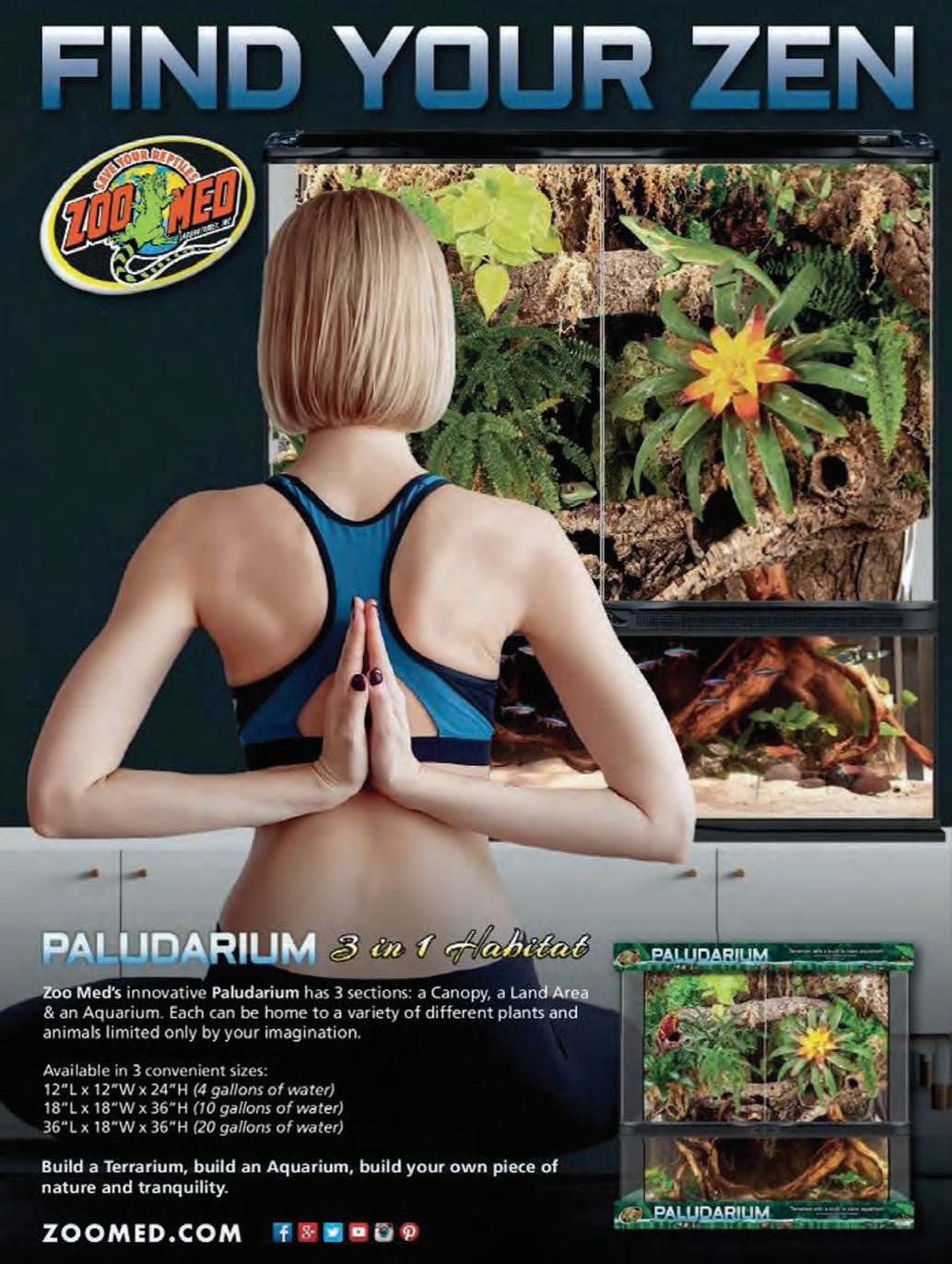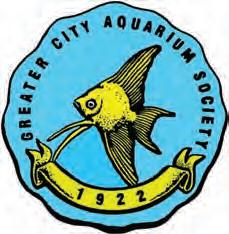September 2023
volume XXX number 7


ON
Our cover photo this month, from our Fishy Friends Photos Facebook page, features a beautiful planted aquarium! The photo is by Victor Huang. Who needs fish?


September 2023
volume XXX number 7


Our cover photo this month, from our Fishy Friends Photos Facebook page, features a beautiful planted aquarium! The photo is by Victor Huang. Who needs fish?

Ihope that our readers enjoy this installment of Modern Aquarium as much as I enjoyed putting it all together. Our member-authors have really out-done themselves this month, and Joe Ferdenzi’s tribute (see page 9) to the late Ginny Eckstein is a glowing celebration of Ms Eckstein’s life and her contributions to our hobby!
Joe also presents us (see page 13) with a wonderful article on Julidochromis ornatus, a small, beautiful cichlid from Lake Tanganyika.
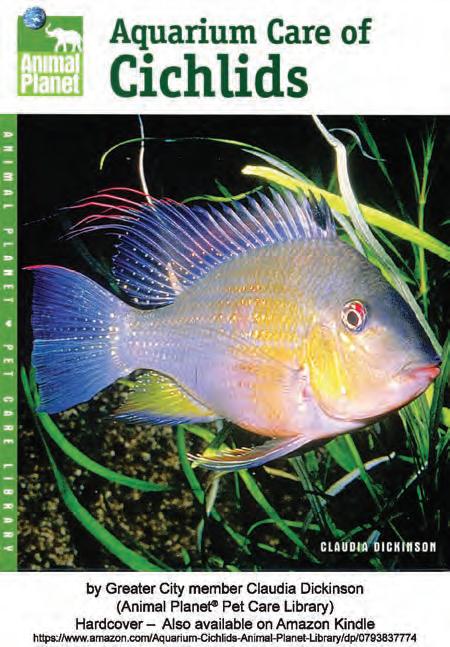
Beginning on page 15, Steve Sica treats us to one of his and Donna’s wonderful diving adventures, this one entitled, “Above and Below in Key Largo.” I am truly delighted to receive this typically beautiful photographic diving article from Steve and Donna. It makes me almost feel that we’re
back from the dead after these past few years of Covid isolation!
For a few years now we’ve been treated to autobiographical essays from (relatively) new member Jason Gold, on the subject of his “Life in Fish.” As another old coot who’s been keeping fish for a good while, I’ve found these to be a very good read, but this time he's out-done himself! Be sure and see his latest installment, “A Life in Fish ‒Borneo,” on page 19! You’ll be glad you did!


Our MA Classics piece this month is really two pieces in one, as they appeared in the September, 2001 issue of Modern Aquarium. Beginning on page 26 is the late Elliot Oshins’ article, “Coming Home a Winner,” which continues at the top of page 27. Below the end of Elliot’s article is a feature we used to run under the sobriquet “The Amusing Aquarium,” a cartoon series by Bernard Harrigan. The cartoon on page 28 is entitled “Pink Panther Grouper.” Enjoy!
Our review of cover photos on Modern Aquarium Series III continues this month with covers from 2016. See page 30. As usual, the issue closes with The Undergravel Reporter and the Fin Fun puzzle. Good Luck!
March 1
April 6
May 3
June 7
Tom Keegan
Fish Biology 101, Part 1
David Banks
Lake Tanganyika Cichlids and Appropriate Tankmates
Emiliano Spada
Antique Aquariums and Equipment
Karen Randall
Sunken Gardens
July 5 Dr. Paul Loiselle
The World of Jewel Cichlids
August 2
September 6
October 4
November 1
Night At the Auction
Sebastian Alvarado
Color Changes In Fish
William Guo
Freshwater Shrimp
Tom Keegan
Fish Biology 101, Part 2
December 6 Holiday Party!
Articles submitted for consideration in Modern Aquarium (ISSN 2150-0940) must be received no later than the 10th day of the month prior to the month of publication. Please email submissions to gcas@earthlink.net, or fax to (347) 379-4984. Copyright 2023 by the Greater City Aquarium Society Inc., a not-for-profit New York State corporation. All rights reserved. Not-for-profit aquarium societies are hereby granted permission to reproduce articles and illustrations from this publication, unless the article indicates that the copyrights have been retained by the author, and provided reprints indicate source, and that two copies of the publication are sent to the Exchange Editor of this magazine (one copy if sent electronically). For online-only publications, copies may be sent via email to gcas@earthlink.net. Any other reproduction or commercial use of the material in this publication is prohibited without prior express written permission.
The Greater City Aquarium Society meets every month except January and February. Members receive notice of meetings in the mail or by email. For more information, contact: Dan Radebaugh at (718) 458-8437, email to gcas@earthlink.net, or fax to (347) 379-4984. For more information about our club or to see previous issues of Modern Aquarium, you can also go to our Internet Home Page at http://www.greatercity.net, http://www. greatercity.org, or http://www.greatercity.com.
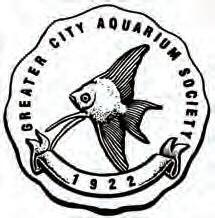
There have seemingly always been aquariums throughout my life. With sometimes as many as forty tanks, there were bound to occasionally be some unusual situations, from floods to sadness to moments of great unexpected joy and excitement, for instance when you end up with 100 or so fish that you didn’t expect. Somewhere in this life I made a program on decorating fish tanks.
I’m now down to a more manageable 20 tanks. That’s still a lot in most (normal) people’s eyes, but it’s been awhile since I made any claims to be normal. Just call me Abby! Besides, there is always that fish whose beauty or rarity or mystery that brings out the “Me Want!” response. You never know when inspiration is going to hit you!
With a bit (or a lot) of effort it might be fun to do a program on “A Lifetime of Fishkeeping, From Beginning to...?” My goodness! I forgot that I’m getting old too! And as I mentioned in my message last month, it’s time for me to end my reign as President of GCAS, and for one of you younger members to step up and take over the reins of this wonderful club.


I have wondered from time to time what our members think about our club, and how it is that our club has continued to thrive for over 100 years now. Greater City has been part of my life for most of that life, since coming to live in the USA. When I first arrived here my first love affair was with the Norwalk Aquarium Society.
Next was the Bronx Aquarium Society—not in existence any more, then LIKA, and finally Greater City, which I have no plans to leave as long as I can keep showing up. GCAS is just part of my life! I love its broad diversity, with members ranging from executives to blue collar workers, and from the highly educated to high school, street-wise folks. The shy and quiet to the most boistrous know-it-alls. All these are here, and all are welcomed and accepted and greeted with open arms. And all the advice you might need or want! Everybody can feel at home. There are members with small 5-gallon aquariums and others with a hundred tanks and thousands of gallons of water! People who are low-tech like me, as well as those who are high-tech, with the latest in technology so they can create a natural-looking environment from a sunny day to a moonlit night. No matter who you are, I promise you will fit in! Plus, we have the greatest city at our fingertips! Have a happy autumn!

Advanced Marine Aquatics
Al’s Aquatic Services, Inc.
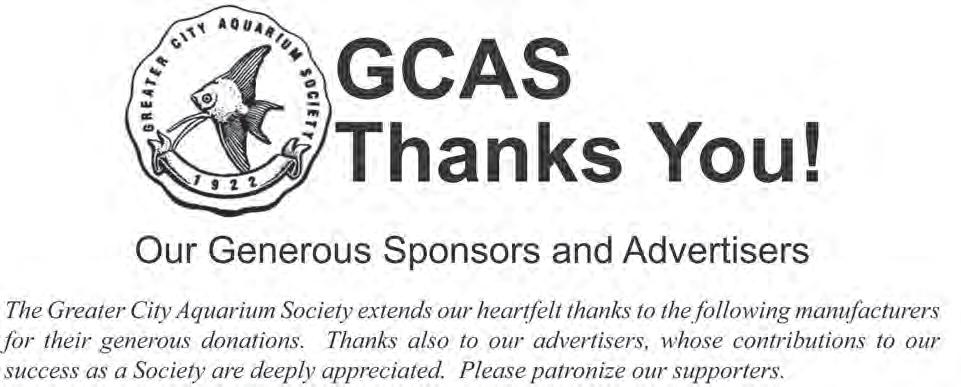
Amazonas Magazine
Aquarium Pharmaceuticals
Aquarium Technology Inc.
Aqueon
Brine Shrimp Direct
Carib Sea
Cobalt Aquatics
Coralife
Ecological Laboratories
Fishworld
Florida Aquatic Nurseries
Franklin Pet Center Inc
Fritz Aquatics
HBH Pet Products
High Quality Exotic Goldfish
Hydor USA
Jehmco
Jungle Bob Enterprises
Jungle Labs
Kent Marine
KHC Aquarium
Kissena Aquarium
Marineland
Microbe Lift
ModernAquarium.com
Monster Aquarium, Inc.
Nature’s Reef & Reptile
NorthFin Premium Fish Food
Ocean Nutrition America
Oceanic
Omega Sea
Pacific Aquarium, Inc.
Penn Plax
Pets Warehouse
Pet Resources
Pisces Pro
Red Sea
Rena
Rolf C. Hagen
San Francisco Bay Brand
Seachem
Sera
Spectrum Brands
Your Fish Stuff.com
Zilla
Zoo Med Laboratories Inc.
 by Greater City Aquarium Society Fishy Friends
by Greater City Aquarium Society Fishy Friends



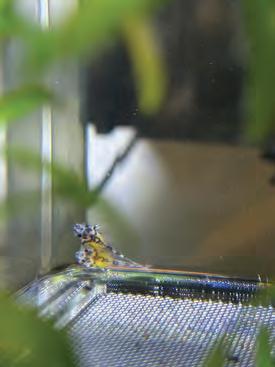
Below are photo submissions to our “Fishy Friends” Facebook group. I’ve left the subjects unnamed, but not the photographer. If you see a shot you like, and want more info, ask the photographer about it! I’m sure he or she will be delighted to tell you!
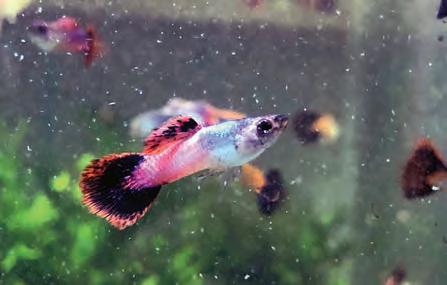
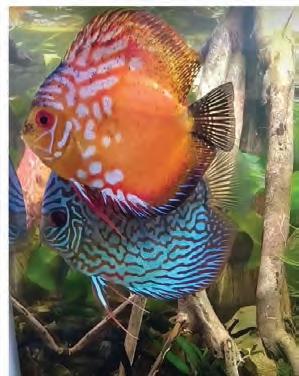

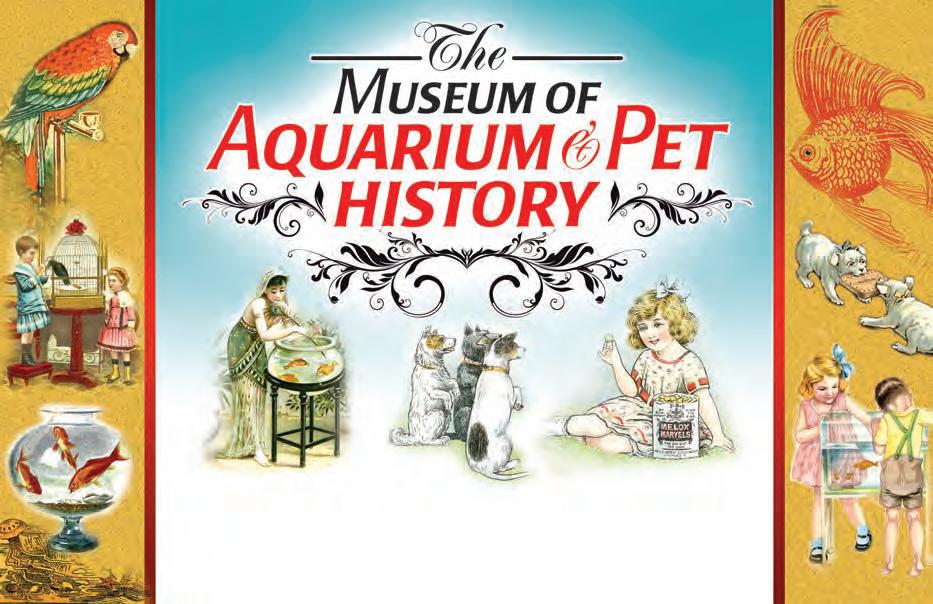
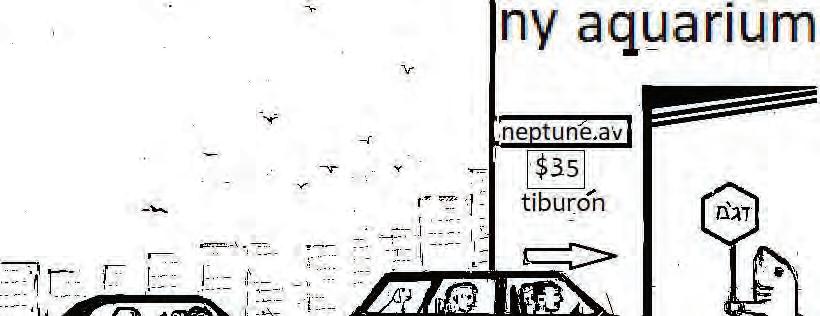

 by Denver Lettman
by Denver Lettman
Modern Aquarium has featured cartoon contests before, and theyʼre back! You, the members of Greater City get to choose the caption! Just think of a good caption, then mail, email, or phone the Editor with your caption (phone:347-866-1107, fax: 877-299-0522, email: gcas@ earthlink.net. Your caption needs to reach the Editor by the third Wednesday of this month We'll also hand out copies of this page at the meeting, which you may turn in to Marsha or Dan before leaving. Winning captions will earn ten points in our Author Awards program, qualifying you for participation in our special ”Authors Only” raffle at our Holiday Party and Banquet. Put on your thinking caps!

Your Caption:
Your Name:
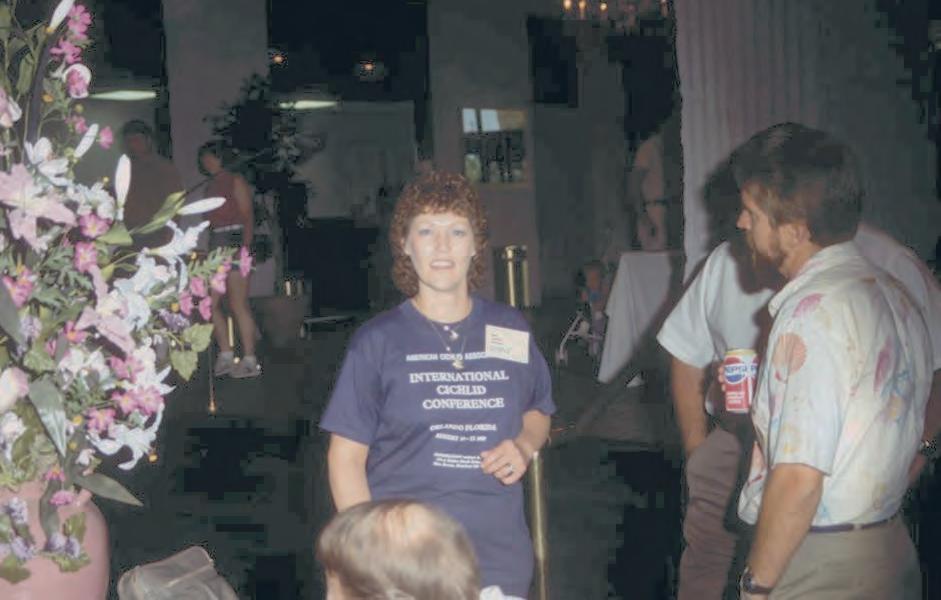 by Joseph Ferdenzi
by Joseph Ferdenzi
On July 29 of this year, the hobby lost one of its legendary members, Virginia “Ginny” Eckstein, after a long illness. Her contributions to the hobby were many, whether it was in making innovative observations about fish behavior, breeding new and difficult species, or her enthusiastic support for the hobby through her many speaking engagements and participation in numerous hobby events. Her passion for the hobby was such that even though she lived in Suffolk County (Long Island), she was an active member of many aquarium societies in the tri-state area, not the least of which was our own Greater City club. In the early to mid-1980s Ginny and her husband Charlie were among the top breeders at Greater City, and their achievements were duly recorded in our Breeders Award Program.
But above all that, Ginny had a spirited personality that was bound to engage anyone who interacted with her. She was generous with her time (she undoubtedly helped scores of beginners) and she had a gift for storytelling and humor.
During the peak of her hobby involvement Ginny was famously featured in an article in Smithsonian magazine (May 1989 ‒ see photo from article on next page). It really showcased Ginny at her finest. One quote from that article should serve to give a glimpse of her personality: “She points out a tank of South American catfish that do not yet have a Latin name because science has never heard of them. She spotted them in a wholesaler’s warehouse, misidentified as another species in the same genus, and uttered a sentence symptomatic of acute accumulitis: ‘I’ll take the tank.’” That was Ginny!
Observant, knowledgeable, adventurous, and enthusiastic—she had all those qualities and more in abundance!
Once upon a time, writing anonymously, Gary Lange, world-famous rainbowfish expert, penned a humorous article entitled, “The Unauthorized ‘bio’ of Ginny Eckstein” for his local club publication. In it, he recounted some of the stories about Ginny that almost seemed too strange to be true, but in fact were true! For example, Ginny trained with NASA as a test astronaut. For another, she owned a large cichlid which started out as a male, then became female, and so was able to both lay eggs and fertilize them! She nicknamed it Tootsie (after the Dustin Hoffman film of the same title—he’s an out of work actor who has to pretend he’s a woman in order to get a job). She owned a large Loricarid catfish that made the local newspaper because of a penchant for eating zucchini (which was then a novelty as far as catfish food was concerned). As Gary wrote of her, “she is drawn to the strange and unusual.” And, as he implored his fellow club members, “Come! Listen to the fast
Conniff, Richard.
talker from the East. Ginny will inform you, entertain you and certainly make you laugh.”

Another fan of Ginny, Craig Morfitt, the founder and long-time President of the aquarium society of Bermuda, recently penned another tribute. She played an important role in that club when she was a speaker and judge at their first five tropical fish shows. As Craig puts it, “Ginny was best known as a catfish expert, but she was also very knowledgeable about the other fish groups. She had a great personality and was a big hit with our members.” Craig also notes that she “was revered for her contributions to fish keeping. It was an honor and a pleasure to have known her, and the club would not have prospered as well as it did without her.”
I think that sums up nicely how all of us felt about her and her contributions to our hobby.
We extend our heartfelt condolences to her husband Charlie and their family. We all know she was a true one-of-a-kind, the likes of which we will, sadly, never see again except in our cherished memories.
“Flashy new ‘items’ make a big splash in the aquarium world.” Smithsonian, May 1989, pp. 90-101.

Lange, Gary (Anonymous). “The Unauthorized ‘Bio’ Of Ginny Eckstein.” Darter (publication of Missouri Aquarium Society), Jan/Feb 1992.
Morfitt, Craig. “Ginny.” Bermuda Fry Angle Facebook, posted August 1, 2023.
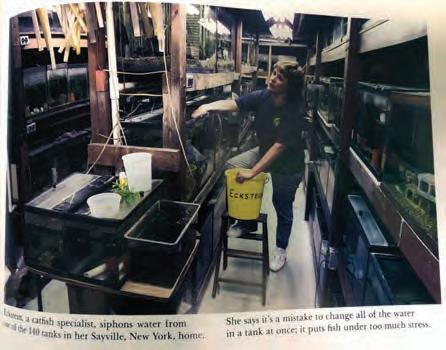

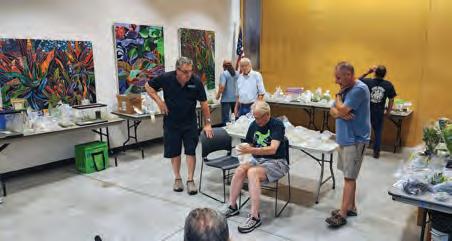

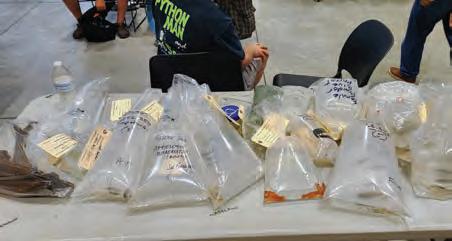




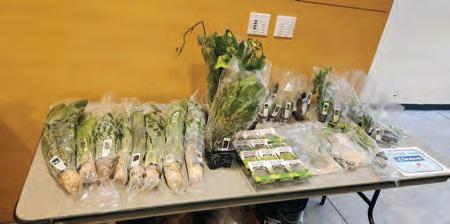


Sebastian completed his Ph.D. at McGill University, and was an A.P. Giannini Fellow at Stanford University. He is currently on the faculty at Queens College of the City University of New York. His research is centered on how plastic molecular substrates can shape a genome to dynamic changes in the environment. This interest has led him to adopt various aquatic systems into his research program, such as Haplochromis burtoni (Burton’s mouthbrooder), Lepomis macrochirus (Bluegill Sunfish), and three different cephalopod species. He primarily studies how these animals change color and their social behavior.

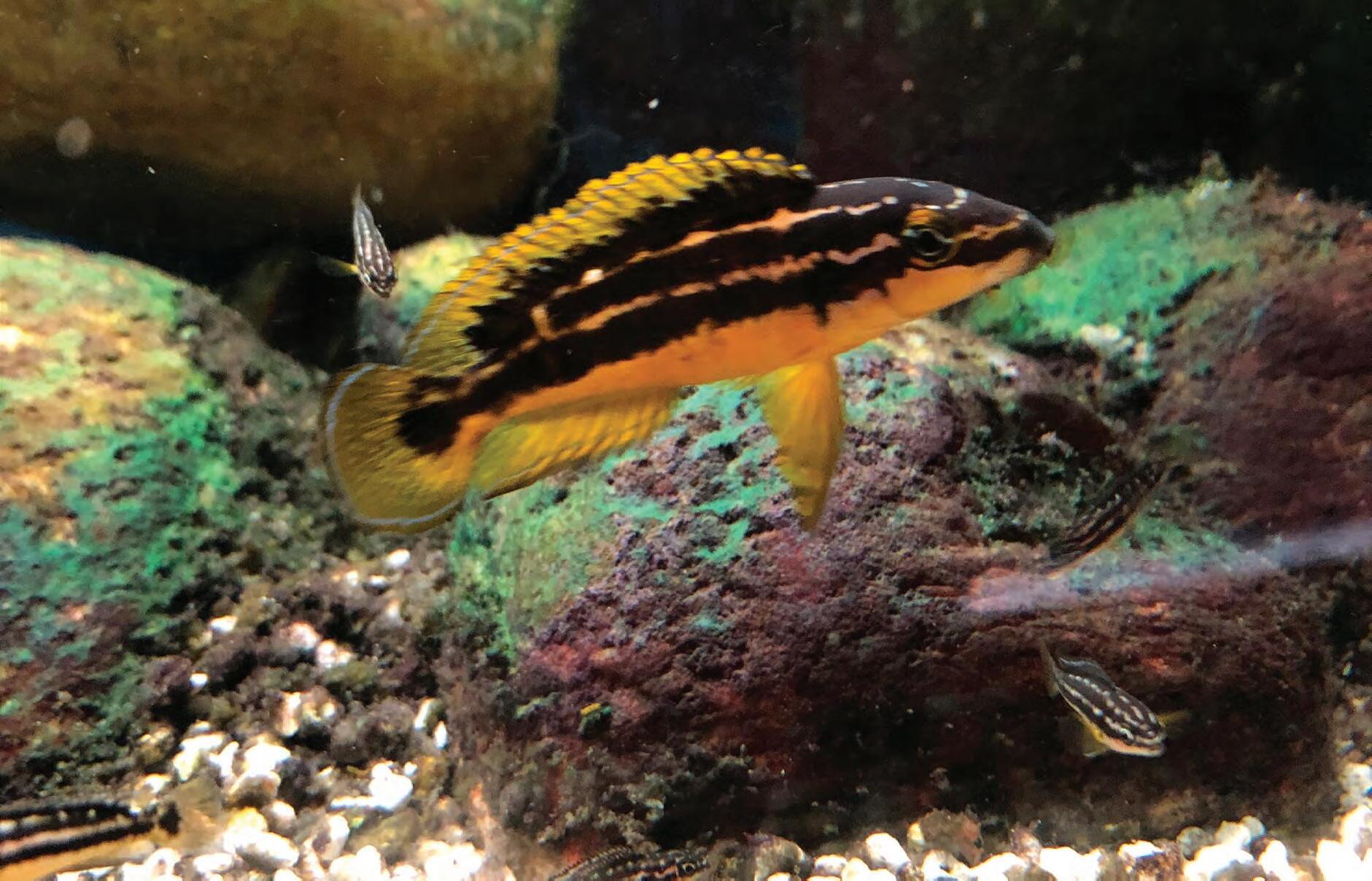 by Joseph Ferdenzi
by Joseph Ferdenzi
Fish of the cichlid genus Julidochromis are native only to Lake Tanganyika in east Africa. Despite that exclusivity, they have been in the hobby for quite some time (for example, there is an article about two of the species in Tropical Fish Hobbyist magazine from October, 1967).
Lake Tanganyika is huge! It is virtually an inland freshwater ocean. It is the second deepest lake in the world (only Lake Baikal in Siberia is deeper). But even though Julidochromis originate in this enormous lake, they make ideal residents of modestly sized aquariums.
Over the years I have kept five species of Julies (the nickname for Julidochromis): marlieri, regani, dickfeldi, transcriptus, and ornatus. The first two can become quite sizeable fish, in the 5 inch range. Dickfeldi are a bit smaller, but the last two are true dwarf fish, with a maximum size of about 3 inches. Hence, I have been able to keep and breed transcriptus and ornatus in tanks as small as 15 gallons.
In nature, Julies are rock-bound — they rarely venture far from their protective boulders. I think that is partly why they adapt so well to aquariums — they are not pelagic fish that require big, open spaces — and hence, large aquariums.
Besides being adaptable to small aquariums, Julies have several other qualities that make them virtually ideal aquarium fish. For one, they are very hardy. Keep their water alkaline and add a tablespoon of salt for every five gallons, and you will never see sick fish. I’ve kept Julies for some 30 years, and have never had even one outbreak of ich or of any other disease. For another, they eat anything in the way of fish food — no fussiness there. Additionally, they are always front and center, displaying beautiful posture. They are not overly aggressive fish, though I prefer to keep them by themselves. Lastly, they are not difficult to breed.
Over the years I have moved on from all the Juies except for one, ornatus. I prefer this species over all the others because of its small
size and brilliant yellow color. I currently maintain a breeding pair with their juveniles in a 15 gallon tank. This tank has been their home for at least the past 16 years.
The tank has crushed coral as a substrate, and the decorations consist of large and medium sized quartz and granite stones that were collected locally (see photo above). The filtration consists of two box filters with crushed coral and filter floss on top. An aquarium light is on 12 hours a day even though there are no plants. The temperature is room temperature, which can vary from 74° F to 78° F. Water changes are done at the rate of 30% once per month.
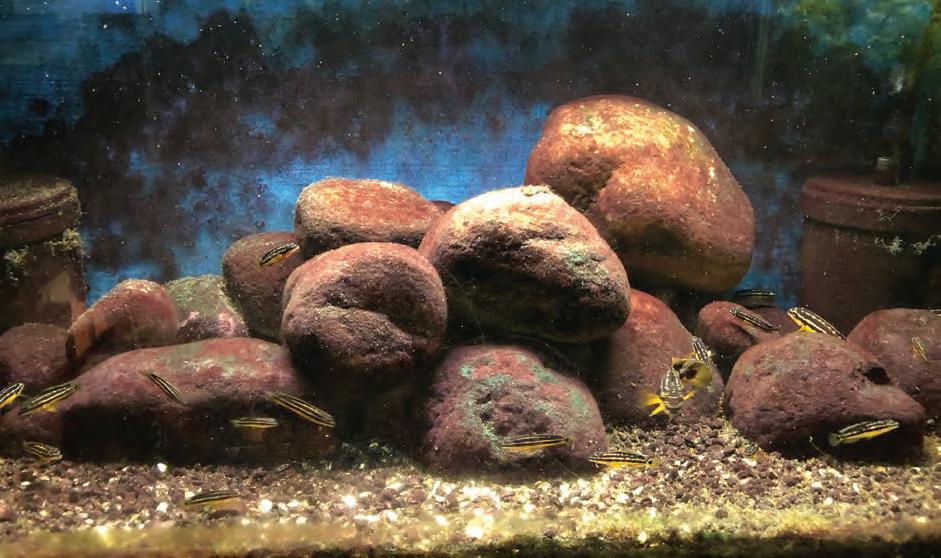
Ornatus are reliable breeders. They take care of their fry very well, and these fry will eat finely crushed flake food right from the start. Of course baby brine shrimp are also a good starter food, and one I use regularly.

My pair of ornatus has been producing fry for me for at least the past 10 years. And here is where an interesting observation is to be had. It is apparent that when the parents sense the tank is too crowded with juveniles, they stop spawning! Time and again, after I’ve removed all or most of the juveniles, I will see renewed spawning activity. Keep this in mind if you have breeding pairs of Julies.
Recently, my ornatus surprised me with another spawning novelty. At first I wasn’t sure that what I was seeing could be correct. But as the weeks rolled on, I realized that it was true: after 9 years of numerous spawns, my normal colored ornatus had produced a batch of albino ornatus! Granted there were only about seven of them mixed in with their more numerous normally colored siblings, but there they were. This was very notable for me, because in all my years of fish breeding I had never had any normally colored fish produce albino fry. This was truly a first for me! The natural world never ceases to amaze!
One note about these albino ornatus is worth sharing. It didn’t take long to observe that these albino fry were not growing as fast as their normal siblings. They appear to be outcompeted for food by the normally colored fry. Also, the normally colored fry could be seen to harass their albino siblings. Therefore, the albino fry were removed and given their own tank.
Want a fish that will give you years of enjoyment and beauty? Give Julidochromis ornatus a try!
In early May, Donna, Cordelia and I drove to Florida to visit relatives and friends.
(See my previous story about Herb and Michelle Walgren.) Our nephew Christopher is employed as a Customs and Border Protection Officer at Miami Airport. He resides in Doral, a small town on the outskirts of Miami and about a twenty minute drive to the airport. Doral is also about sixty miles from the Holiday Inn that we enjoy staying at in Key Largo. If traffic is light, it is about a one hour drive from Doral. We made plans to drive from Doral to meet Chris, his lady friend Stephanie, and Donna’s sister and her husband at the hotel.
Stephanie is employed by IHG Hotels and Resorts, and secured for us savings at these hotels that have, in my opinion, become overpriced during and since the pandemic. From our home in Queens Village to the Key Largo Holiday Inn it is 1,375 miles by car.
Donna, Chris, Stephanie and I decided to spend a Sunday morning diving the waters around Key Largo. The weather was lovely, but we decided to hire a dive guide, since Donna and I have not been underwater since late October 2019.
We woke up early on Sunday morning. The dive boats usually leave around 8:30 AM to get back by early or midafternoon. If more than one boat is heading out to the same dive site, the first one there gets the premier mooring ball. If too many dive boats want the same site, you may have no place to moor or tie up to. Larger boats in the Keys do not drop anchors, because there is a chance of damaging reefs. If there is no place to moor, the boat captain is forced to choose another dive site. This dive site may be less ideal, but no matter where you may desire to dive, the captain always has the final say.

Our boat left the dock before 9, and we headed out of the canal to the open sea and the reefs. We were warned that the seas were unusually rough that morning. In fact, the afternoon dives were canceled for that reason. Our first dive was the wreck of the Benwood that we dove three or four times previously. This shipwreck is noteworthy for vast schools of fish in water less than fifty feet deep. We assembled our gear as we headed out, and were given the ten minute warning to finish putting on our wetsuits, boots, gloves, hoods, or whatever you prefer to wear in the water. Obviously, this depends upon the water temperature and protecting yourself from animal and coral stings and scrapes. It evolves into a habit or ritual for a veteran diver as to what gear one prefers. I like to wear a light neoprene beanie on my head because I have no hair. If I bump my head on the boat ladder, or a coral head, or someone kicks me, I have some protection. Donna does not like to wear anything that might cover her ears, despite my belief that a
hood or beanie will keep her warmer. Being very thin, she usually gets cold. In early May the water temperature was about 80 degrees. Ironically, two months later, the surface temperature in the Florida Keys is over 93 degrees! Years ago, in August we dove in 85 degree water about fifty miles down the Keys in Islamorada. I remember being quite warm in a lightweight, non-neoprene diving suit. Donna is never too warm!
When we swam down to the sandy bottom twenty yards from the Benwood, the first fish that I saw was a Southern stingray lying in the sand. The stingray spotted me paying too much attention to it and swam away into the misty sea.
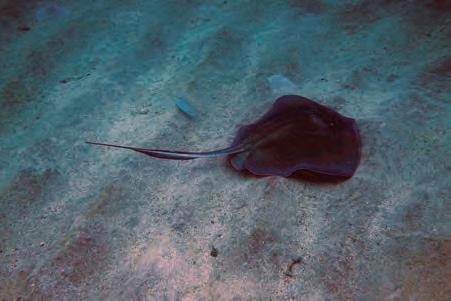
Back to the Benwood wreck. Rainbow Reef’s dive boat (one of four or five that this dive outfit uses) already had the best mooring ball close to the wreck. Now we had a longer swim out and back. If possible, you try to make any swim underwater. It’s usually much easier. Thank goodness for our dive guide, because I did not want to concentrate on finding the wreck and our boat afterwards. If one’s navigation skills are mediocre, the easiest method is for one person to surface, find the boat and either swim back down, or lead on the surface. Once I re-submerged and led Donna past the boat. A sure sign of incompetence! A dive guide was handy because I wanted to take photographs.
I walked off the back of the dive boat. A deck hand handed my camera down to me as I bobbed in the water off the transom. I kicked my legs up and swam towards the bottom. Oh no, it was the worst visibility that I had ever encountered in Key Largo! Visions of an entertaining article and photo layout for
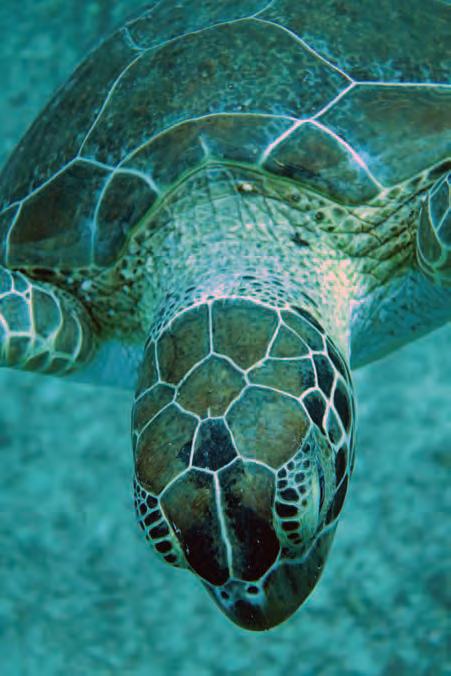
Modern Aquarium fled out of my head. I was disappointed. Scuba diving is not an inexpensive sport anymore. They offer no guarantee other than that you will be in and see water! Seeing reefs and fish is an add-on!
deck, sides, and bottom of Benwood’s hull for about a half hour and then we did the sand and reefs around the ship before surfacing.
Back on the boat, we switched our buoyancy compensators and regulators to a fresh cylinder of air while the captain looked for another dive site—this time a shallow reef. The preference is to dive deeper sites first and shallower next to hinder the buildup of nitrogen gas in the bloodstream. A longer surface interval between dives is also favored to allow nitrogen to exit the blood and body via breathing.
The wind had churned up the water but it wasn’t that windy. I’ll blame it on climate change! We swam underwater to the wreck. I could see fish schools hovering in the hazy water all around the deck, but it was impossible to photograph them. We swam a bit along the deck and began to see small hawksbill turtles. Not a fish, but I wanted to take photos of something. I did think, “Turtles in a fish publication. What would Al Priest say?”
We swam around and I saw a few fish too difficult to photograph. I needed to get close to photograph them, but they were having none of it. I could not see them very clearly, but they sure could see me and wanted to keep a safe distance. We swam around the
The second dive site was thirty feet down, and the sun had risen higher in the sky, so the water clarity appeared improved. Fish were still scarce. One of the problems is that as reefs die off due to the increase in water temperature, the fish leave or are just not as prolific. There is also the lionfish, that will devour every juvenile fish that it can find.
We swam around the reef and its surroundings for about forty-five minutes. By

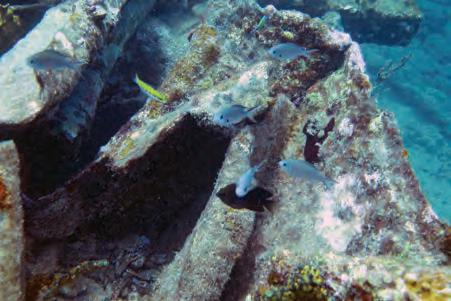

then we were becoming cold. I could clearly see that Donna was chilled, so we surfaced and clambered onto the ladder and boat one at a time. We peeled off our wetsuits to dry up. Once the balmy sun had soothed our bodies, and we began to warm up we eagerly

looked forward to the boat ride back to the dock. Although the seas were wavy, no one on the boat got seasick or had to heave over the side. See, you can always find a “silver lining” in whatever you do! If that sounds silly, you’ve never been seasick!


Some Key Largo soft corals. We saw them firsthand. There is a good possibility that you will only see corals in pictures someday soon.
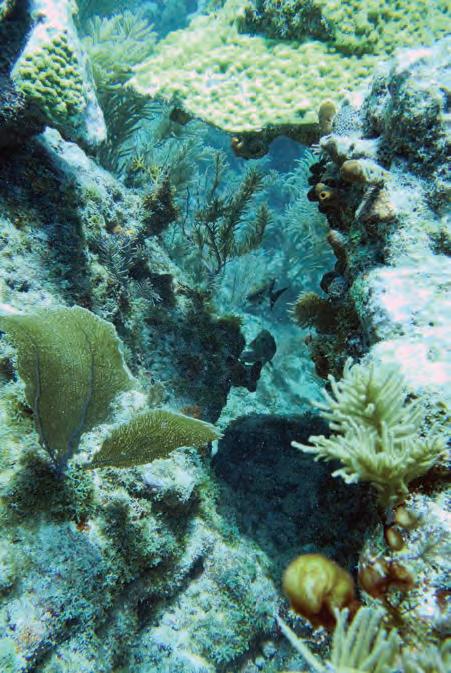
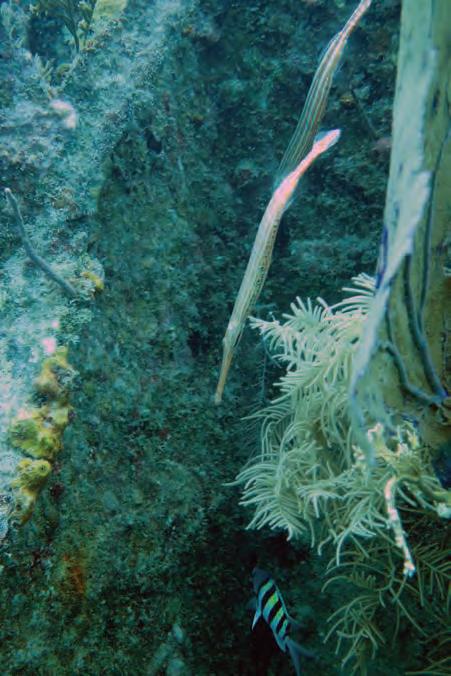
In 2009 I turned 50. I was a single dad in Manhattan, with a daughter in college and a son in high school. I had a good job, but also a lot of expenses. There wasn’t much left for my hobbies and certainly not for travel. Especially not the sort of travel to remote and untouched places I’d longed to visit since my childhood spent projecting myself into the faraway adventures of the intrepid fish explorers profiled in Tropical Fish Hobbyist.
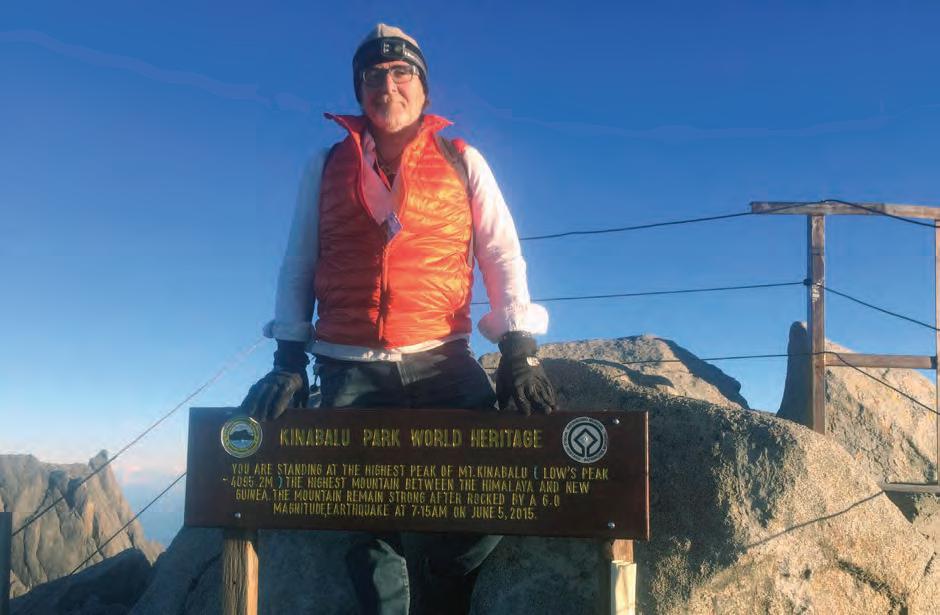
I got a call from my parents: “We’ve been thinking about your birthday…” They told me that with such a watershed birthday coming up, they’d like to give me something big, so what was something big I really wanted? I knew the answer immediately: “Well, you know, I’ve always wanted to go to Borneo.” It was a place that had gripped my imagination and captured my heart since I was a kid, a land of jungles and orangutans and lazy blackwater rivers full of loaches and rasboras and gouramis. And well, they’d asked, and it was an honest answer.
My father’s immediate reaction was, “that’s ridiculous.” Dad didn’t like to travel and didn’t understand why anyone else did either. And that was that. The immediacy
and negativity of his response stung, even at almost 50. As I recall it now, the whole incident seems very entitled and childish on my part. But in that moment they’d raised my hopes of fulfilling a childhood dream, and it was the child in me who was so disappointed. My adult self dealt with it just fine. The dream, however, remained.
Six years later, I got a call from the HR person at the architecture firm where I’d worked for 15 years (and still do). “Jason, you know you have a stockpile of unused vacation days—over a month’s worth—and you’ve got to use them or we’ll just pay them out.” Huh, so they were encouraging me to actually take a long vacation? The same people who panicked if I took so much as a three-day weekend in August? I started to consider the possibilities. I discovered, much to my surprise, that it’s actually not all that difficult or expensive to get to Borneo, but it takes time, and now I had the time—with pay! I found an 11-day tour of Sabah, the Malaysian state encompassing the northeast corner of the island, through Intrepid Travel.
Borneo is the third largest island in the world, after Greenland and New Guinea. Long Island, FYI, is 149th. The northern third of Borneo is part of Malaysia, including the states of Sabah and Sarawak, and the rest is part of Indonesia, collectively called Kalamantan, except for a notch in the northern coast which is the Sultanate of Brunei. I’d talked to Intrepid at the NY Times Travel Show at the Javits Center a few years before—the dream, as I said, remained—and knew that their rough-and-ready approach was a fit for me: small groups, unfancy hotels, and a focus on physical experience in nature and opportunities to meet and interact with locals. I could go in early March and be back, all tan and full of stories, in time for a family wedding in Boca Raton later that month. I’d travel for two weeks and get the payout for the rest of my unused vacation time. It seemed very much within reach. I was incredibly excited.
While I was considering all this, the stars intervened. Or, rather, the Earth was set to intervene between the Sun and the Moon. There would be a total lunar eclipse visible in NYC, an unusual ‘blood moon’ event in which the Moon passes through the deep central shadow of the Earth, the umbra, not just the less dark peripheral shadow, the penumbra. The local press was making a big deal about it. I got a call from my daughter. She was a few years out of college at that point, living in Crown Heights and getting herself established as a journalist. She blogged for a popular women’s issues and pop culture site called Jezebel. But when she was a little kid, after her younger brother had fallen asleep in the bottom bunk in the room they shared, she and I would talk late into the night about, well, the Universe. She’d ask questions like, “Why is the sky blue?” and “Why is the sunset red?” and “How does the moon change its shape?”
I was a die-hard science and nature geek from

day one and knew a lot of the answers, and what I didn’t know I’d find out overnight and tell her on the walk to school the next morning. Anyway, she called me up and said, “Hey Dad, want to meet in Prospect Park to watch this lunar eclipse thing, and you can tell me how eclipses work?” It was a sweet and touching offer, an evocation of those bunk-bed talks, and yes, of course, I would totally, totally, totally love to!
But I wanted to brush up on how lunar eclipses worked and what made this particular one so special. So I hit the internet, and as we all know, when you start looking at stuff on the internet (or start telling a fish story), one thing leads to another and another and another. I landed on the NASA Eclipse Web Site, which led me to read about solar eclipses as well. I learned that a total solar eclipse would occur the following March—9 March 2016 to be exact— the path passing directly over Borneo and the adjacent islands before heading out over the open Pacific. Every geeky cell in my body— i.e., every cell in my body— shivered with nature nerd excitement. I’d never witnessed a total solar eclipse, and here was a chance not only to experience one, but to do so in a place of my wildest childhood fantasies.
I started researching every spot within the narrow path of totality to see if it was conceivably possible that I might be able to get to any of them on the appointed day. I’d never heard of any of these places: Palembang, Balikpapan, Ampana, Ternate. The eclipse would be early in the day, so it had to be someplace with an open view toward the morning sun—no jungles or west-facing beaches or places perpetually shrouded in clouds and mist. Also, any of these places would be a challenge to get to and totality itself would last not even two full minutes, so it’d be great if wherever it was, there was something else interesting to do there for a few
days to make it all even more worthwhile. I clicked on another speck in the path of totality, the Togean Islands, a tiny archipelago in the Gulf of Tomini between the north and central peninsulas of the large Indonesian island of Sulawesi, Borneo’s neighbor to the east. It was a scuba paradise! So I could witness the eclipse and spend the rest of my time hanging out with the fish. Perfect!
But that was a completely separate twoweek itinerary. I would have to choose between my dream of Borneo or this new upstart dream of the eclipse and the diving. I couldn’t afford both. The holidays were approaching, and I had to decide, when something else happened, nudging me on. It turns out that we’d had a very good year at the firm, and my holiday bonus was double what I usually received! Typically the bonus went to buying holiday gifts and paying down my credit card, and that was that. But this time there’d be something left over, enough to make it all possible. It took a few days to do all the research on transportation and accommodations. Getting from Kota Kinabalu, on Borneo, to the Togeans involved five taxis, four planes, two hotel rooms, an overnight ferry and a speedboat. I moved the Sabah portion of the trip to late February, because the eclipse was during the time I’d originally thought I’d go there. Then I went online and that earlier Intrepid trip was actually on sale at a reduced price! The heavenly bodies had indeed aligned, and the countdown to liftoff began. T minus six weeks, and counting. Malaysia and Indonesia have a solid tourism infrastructure but don’t attract huge numbers of Western travelers. The prices are aimed at locals and are jaw-droppingly inexpensive by US standards. (The local exception is Bali, in Indonesia: lots of Western tourists—therefore much higher prices.) In the Togeans, I stayed at the Blue Marlin Dive Resort, the fanciest place in the archipelago.
My private cabana on the beach, facing the sunset with the smoking cone of the volcano Una Una on the horizon and including three meals a day, cost about $24 per night. That’s about the same as chicken parm at an Upper West Side diner. The diving was extra, but even that was literally a quarter of what I’d paid in Florida or Barbados, the only places I’d been diving before. So don’t think this sort of thing is totally out of reach, because it’s not. But even the fanciest place around was still very rustic by US standards. The cabanas had electricity and hot water for two hours in the morning and six in the evening. There was no air conditioning, but the walls were open at the top to allow the trade winds to cool things down as I slept to the sound of the lapping waves in a totally comfy bed surrounded by a veil of mosquito netting. While the electricity was still on in the evenings, droves of moths and other insects were drawn to the lights, and whole platoons of geckos arrived to feast on them. It was a National Geographic special each night, right there on the ceiling! They told us that if we had any food in our cabanas, we should hang it on the hooks in the bathroom, out of the reach of rodents. I dutifully followed those instructions. But the second night I was startled awake by a clatter in the bathroom, grabbed my head lamp and aimed it toward the noise just in time to see a pint-sized tarsier turn its huge glowing eyes in my direction before it dashed out the window, a chocolate cookie clutched in its tiny hand. A midnight jones for

a chocolate cookie is apparently something we share with our primate cousins.
And what about the fish part? Well, there was the magnificent diving in the Togean Islands of course, and the eclipse, oh my God, the eclipse! Yes, there was a fish-y element to the eclipse. We took a boat early that morning to another tiny island where they thought we’d have a better view of the celestial conjuncture, and as I splashed ashore, the beach was alive with startled mudskippers scattering into the mangroves at our approach! Mudskippers! Way cool!
But what about the freshwater fish that had inspired the trip in the first place? It didn’t take long for me to find those. My long-haul flight on China Southern was from JFK to Kuala Lampur via Beijing. I had an

architecture friend, Mehi, who’d taken a job in KL a few years before, and he was happy to put me up for the first and last nights of my trip. I arrived at his place in KL in the wee hours, and over a 2AM snack of leftovers from the fridge he gave me a list of places to see the next day before I continued on to Borneo very early the following morning.
His itinerary was very architectural and ordered—a numbered loop through the city so I could see as much as possible in the one day I’d be there. When I woke up only a few hours later, he’d already left for the office, and I quickly shook off the dust of the long flights and some serious jet lag and hit the teeming streets of Kuala Lumpur. At about 10AM, my cell phone rang—Mehi checking in. “Hey, I
was just wondering how you’re doing and when you think you might be heading out.” “I’m great, and I’ve been out for two hours already! I’m already at Number 4 on your list!” Later that day, after stopping at the street market outside the National Mosque and downing a restorative bowl of some seriously spicy fish soup and a soothing ice pop made from a fruit I never did identify, I made my way through the historic Chinese market district in the center of the city. Number 8 on the list. It was a real local market—lots of food and clothing and housewares—except for the more touristy, souvenir-filled and pagoda-shaped market hall at the center. And among the narrow streets lined with vendors, I came across an aquarium fish dealer! I stopped dead in my tracks. Fancy guppies and goldfish, decidedly un-exotic but still old friends. The local guy who ran the place spoke English, so I talked to him for a while. He took me in the back and showed me his holding tanks and breeding set up, about a hundred 20H tanks. Really cool! I noted that what he had for sale wasn’t local and asked if he ever dealt with fish native to the area. No, he said, that’s not what the local hobbyists are interested in, but there were some places, big breeders and exporters at the outskirts of the city that he could recommend. How long was I going to be in KL? “I’m leaving tomorrow morning for Kota Kinabalu.” “Ah, Borneo, excellent, you’ll love it. But you won’t have time to go to any of the places I had in mind outside of town.” Oh well, all the more reason to return to KL some day.
The next morning I flew to Kota Kinabalu, the capital of Sabah state in Malaysian Borneo. There I met my Intrepid group—in all, four Americans, four Aussies, and two Brits—and our fabulous Sabahan guide, Richard Lingki. We walked around town that first evening, and at the night market facing the South China Sea, shared a spectacular seafood feast right on the wharf for only a few dollars apiece. Our waiter was a local kid—maybe 10 or 11—with perfect idiomatic English and the charm and patter of a born salesman. The kid definitely knew how to work a crowd. Back at our hotel, Richard told us that breakfast was at 8AM the next morning, and then we’d head up into the
mountains toward Mount Kinabalu, which we’d be climbing a few days later. But he added that the market in the center of town opened at 6AM if any of us were up for an early morning. I was in the town center by 5:30, watching the locals set it all up. I mean, sure, I’d been in transit for four days and was totally disoriented by jet lag, but as in KL, I hadn’t come all that way not to experience everything I could.
There were, as expected, mountains of gorgeous and exotic produce and spices—I’d never seen so many different kinds of bananas and peppers! There were cages and bins of live birds and hamsters and other livestock, an endless array of seafood, handicrafts, textiles, candies, and cookies (tarsier bait). There were vendors selling garden plants—tropical fruit trees and bougainvilleas and orchids—and others, yes, selling aquarium fish. Jackpot!
The aquarium fish vendors were all in this one little square. The fish were in plastic bins or in bags clipped to tall frames or poles. Fish trees. Aquatic plants in plastic bags were clipped to a clothesline above. So this is what an aquarium store looks like in Kota Kinabalu! Some of the fish were non-native aquarium staples—guppies and Gambusia and fancy goldfish. But most of what they had for sale was from Borneo or nearby, all sorts of rasboras and barbs and loaches and especially anabantids.
and when traveling in such a foreign place it’s great to see a familiar face even if it is the thick-lipped pout of a gourami. And from that moment on, every cryp-lined river, stream, creek, ditch, pond, or puddle we passed by or slogged through or over while driving through the countryside or trekking through the jungle or visiting a preserve was, to me, a hidden aquarist’s paradise, a repository and a realization of my childhood dreams. I couldn’t see them, but I knew they were there.
Some of the fish were new to me, although without a common language I couldn’t ask the vendors about them. But many were species we know from the hobby here in the States,
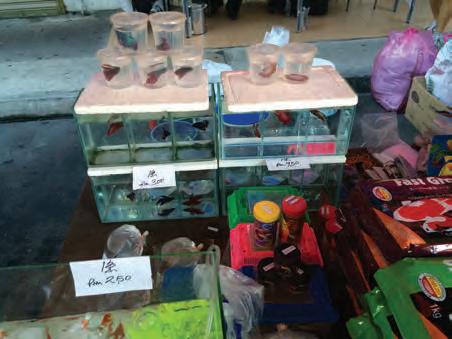
A few days later, we climbed Kinabalu, the highest peak between the Himalayas and New Guinea. In preparation, we had been gaining elevation and going on short hikes for three days before we arrived at Kinabalu National Park. The park headquarters included a botanical garden of Kinabalu flora as well as information about the mountain’s fauna. One sign was about the three freshwater fishes native to Kinabalu’s streams, all coldwater loaches I’d never heard of: Glaniopsis denudata, G. hanitschi, and Protomyzon whiteheadi. So I was in loach territory! The first day of the climb, we rose from the steaming jungle carpeted with wild native impatiens and begonias and draped with orchids, with the screech of gibbons and hornbills heralding our every move; through Jurassic-seeming tree fern forests with pitcher plants clambering up their shingled trunks, brazenly offering their vessels of sweet, deadly nectar to all hapless takers; into the misty alpine zone of heaths and heathers and brooms, presided over by magnificent and ancient Vireya rhododendrons

with their cream and yellow and orange bells; and finally, on the second morning, to the bare granite peak at sunrise.
Gotta say, at 56 years old, the climb nearly killed me. In the first hour my thighs were already screaming “turn back!” That was long before we even got to the higher elevations where we had to hoist ourselves up mile after mile of huge granite blocks, a giant’s endless staircase ascending into the thinning air. But I got into a sort of rhythm, and the endorphins I remembered from my younger days as a hiker and long-distance runner kicked in. Once that happened, there was no doubt in my mind that I’d make it to the top. And I did, after a final four-hour pre-dawn push to the summit as the rising sun cast the long shadow of Kinabalu across the surrounding jungle from our perch at the top of the world. Breathtaking! And at 13,435 feet, you can take that literally.
But coming down was much harder. My left quadricep was done, finished, it just stopped responding; it could follow but it could no longer lead, and I had to initiate every step with my right leg. Most of the rest of our group was safely back at our inn at the base, enjoying their dinner, while I was still struggling down the mountain in the dark with one of our guides, Mr. Toppingi. I never learned his real name; his moniker just meant he was from the village of Toppingi. But he was fantastic and patient and wise and did get me safely down the mountain.
Another pair in our group, a mother and son from Australia, didn’t make it down until the next morning. She had been felled by altitude sickness a couple of kilometers shy of the summit, and they’d spent the night at a ranger station halfway down the mountain to ease her reintroduction into the world of enough oxygen. I was a little self-conscious that the return trip had taken me so much longer than almost everyone else, and was actually kind of relieved the next morning to see that everyone, even the youngest and fittest in our group, were also limping with pain despite the shared elation of having completed that part of our journey.
I had two more encounters with aquatic life over the course of the ensuing days in Sabah. First, we spent a night at the Turtle Island
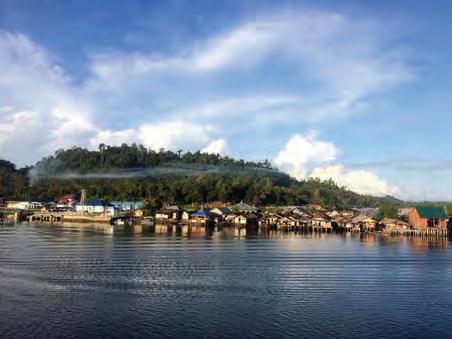
Preserve in the Sulu Sea, where every night of the year huge sea turtles haul themselves ashore to lay their eggs. We’d be alerted when the first turtle came ashore to make its nest, and had to be on call until then. It was liable to be a late night. But first we toured the facility where they incubate the turtle eggs, a veritable turtle farm in an enclosure that keeps the buried, developing eggs safe from the huge, prowling monitor lizards that would enjoy nothing more than unearthing turtle eggs for breakfast, lunch, and dinner.
Then we had a chance to relax a bit on a perfect palm-lined beach with the southernmost islands of the Philippians visible on the horizon. Just another day in Paradise. I grabbed a snorkel and fins and headed out to the breakwater reef near shore, where droves of colorful fish darted among the corals and anemones, a prelude to the wonders I’d see in the Togeans. That night, the call came at about midnight, and we were led to a different beach
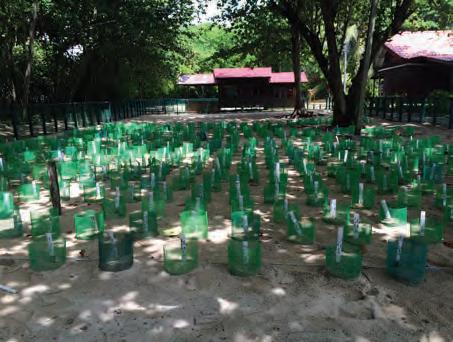
to witness the eerie, slow-motion spectacle of a large female hawksbill turtle laying her eggs in the pit she’d excavated at the base of the dunes, and after that, a basket of that day’s hatchlings from the turtle farm being released to make their frenetic dash to the sea. A lucky few would return to that same spot years later to repeat the cycle that had been playing out for millennia on that moonlit shore.
A few days later we were at the Sepilok Orangutan Preserve, where orphaned orangs are nurtured and prepared for reintroduction into the wild. These close cousins of ours are amazingly human-like, not only in their complex behaviors, but in the subtlety and variety of their facial expressions. Mischievous, playful, wary, bored, curious, caring—it’s all there on their faces and in their eyes.

Sepilok also had a similar facility for another endangered local animal, the sun bear. At the little shed from which we could observe the sun bears going about their day
was something that everyone else passed by with barely a glance, but which totally riveted my attention—a large aquarium of native freshwater fish. Huge scissortails and other rasboras schooled among the cryps and

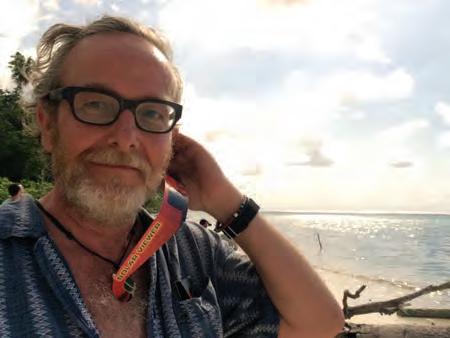
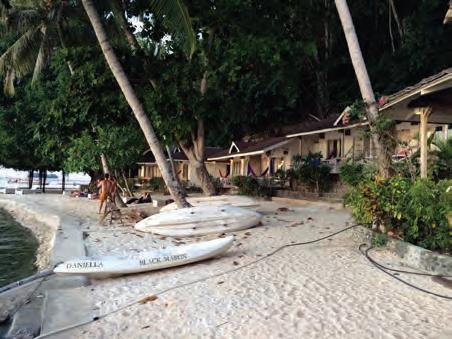
water sprite, a biotope tank only a few feet away from the biotope itself. “What took you so long in there?” my companions inquired. “There was this amazing tank of native fish, all these rasboras…” But they’d already heard me gushing about fish for over a week at that point and had moved on to watch a wild orangutan watching us back from a branch within an arm’s reach of the elevated walkway where we stood. OK, this is beyond amazing, for sure. But I was still thinking about those scissortails. There in the heart of the Bornean jungle and all its wonders, the stars aligned, my childhood dream realized, my heart still belonged to a rasbora.

My calendar shows me there is a fish meeting today, so I know my good friend Ed will pick me up on time. I have often thought to myself, “It’s very enjoyable seeing friends, even though it’s only once a month.” I believe all our members will agree with me that our meetings are special, and a fun way to spend an evening. I always look forward to the guest speaker, who will add to the enjoyment of the meeting by giving a knowledgeable talk on the different types of fish, plants, and equipment available to us.
One of the highlights of our meeting is the auction. It is a great place to buy fish that our members breed and the plants that they grow. A fun part of the evening is the raffle. It’s a must, as it supports the club and is a great place to pick up those cans of fish food. And the pièce de résistance is when Claudia Dickinson hands out all the goodies. What more could you ask?
You can’t beat the killifish that Harry Faustmann brings in. And of course when it comes to plants, the Curtin brothers have the green thumb. Speaking of plants, a “hats off” to Anton Vukich for bringing in not only the great fish that he breeds, but also his varied and beautiful house plants. For baby koi angel fish, you guessed it – Jeff Bollbach. I believe every fish club sells snails, and we are honored to have Rod Du Casse, the Warren Buffet of the snail world. We are very grateful to him, and to the other members of the club, for making the auctions so successful.
The word “auction” is derived from the Latin augere, which means “to increase” or “to augment.” Auctions have a long history, having been recorded as early as 500 B.C. by Herodotus in Babylon. Auctions of women for marriage were held annually. When the auction began, the auctioneer would start with the most beautiful women (talk about an exciting auction). I don’t think words can describe what must have gone through the minds of the crowds of men attending the auction. In those days a man could have more than one wife, and the envious men looking on without the means of buying a wife must have felt very frustrated. It must have been very stressful for the women who did not have an easy life, or who were not very attractive. It was also considered illegal to allow a daughter to be sold outside of the auction. I might be cynical, but we do have trophy wives today, so I wonder how far we’ve really come.
The United States had slave auctions before the Civil War, which is a great shame of our history. In the 1950s, The Hudson’s Bay Company had auctions in New York selling raw and dressed fur pelts, which was
big business at the time. In Tokyo, tuna auctions are very popular, as the Japanese are the world’s leading consumers of bluefin tuna. And do you remember all the TV commercials showing the auctions of tobacco for cigarettes? My, how things have changed.
An oil painting of a portrait by the artist Francis Bacon sold for 27.4 million dollars at Sotheby’s in July 2008. Sotheby’s has a staff of highly trained personnel who will advise the clients on the value of paintings in today’s marketplace. If the price is not met, the painting is not sold, but bought back by the auction house.
At our club’s auctions, it would be nice if the club would set up a team of experts to put a value on the fish brought in for auction. I recommend Warren Feuer, Mark Soberman, and “The Maven” a/k/a Artie Friedman. Even though our auctions bring in very little money, we should run it in a very professional and businesslike manner. As most of the high-end auctions require the head auctioneer to be dressed in formal wear, it would be a novel idea for our President Joseph Ferdenzi to be dressed in black tie. I think Joe would look very handsome and debonair. He should have two spotters. I recommend Ed Vukich and Al Priest. The spotters should be dressed in business suits or sport jackets. White or blue shirts would be a must. Our auction should be run like those of the big auction houses – very elite, very professional. So get with it men, this is your time to shine! Shorts and tee-shirts are out. Think how our standing will rise compared to the other clubs. Let’s show them the way! At our auction, the last hand remaining up is the buyer. Sometimes a hand is not seen, so I suggest small flags be used that can be waved back and forth to be noticed. If that does not work in a hot auction, the bidders can be equipped with whistles. We could also have
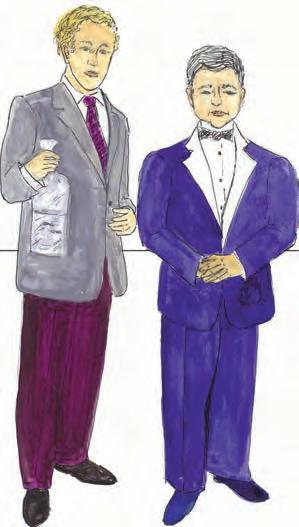
of work, but in the long run no sale would be missed. And I know the accounting staff run by Jack Traub would be very happy with the extra revenue.
well-suited to small tanks. But even though they are small, they do much better in larger tanks for many reasons, not the least of which is that it is easier to maintain a consistently high water quality in a larger tank than it is in a smaller tank. It should be noted that honey gouramis are highly sensitive to poor water conditions, and they are very susceptible to the parasitic disease oodinium, otherwise known as velvet.
wave your flag and blow your whistle. Be proud that you are the highest bidder going home with the top bag of fish. Be a winner! As they say at the casinos in Las Vegas – LOTS OF LUCK!
paddles in very bright colors. It might sound like a lot of work, but in the long run no sale would be missed. And I know the accounting staff run by Jack Traub would be very happy with the extra revenue.
well-suited to small tanks. But even though they are small, they do much better in larger tanks for many reasons, not the least of which is that it is easier to maintain a consistently high water quality in a larger tank than it is in a smaller tank. It should be noted that honey gouramis are highly sensitive to poor water conditions, and they are very susceptible to the parasitic disease oodinium, otherwise known as velvet.
As a quick summary, when kept in a heavily planted species tank with high water quality, this small fish can live up to four or more years in
As a quick summary, when kept in a heavily planted species tank with high water quality, this small fish can live up to four or more years in
So let the bidding begin! Hold your hand high, wave your flag and blow your whistle. Be proud that you are the highest bidder going home with the top bag of fish. Be a winner! As they say at the casinos in Las Vegas – LOTS OF LUCK!

captivity. Because of its sensitivity to even small changes in water conditions, intolerance for poor water conditions, susceptibility to velvet disease, and challenges in raising fry, I would have to say that this is definitely not a “beginner’s” fish, and is far from an ideal fish to acquire if all you want to do is rack up some quick and easy Breeder Award Points at your local aquarium society. But, for the more experienced aquarist, successful long-term maintenance and spawning of the honey gourami can be a very satisfying and rewarding experience.
Illustrations by Elliot Oshins
References
captivity. Because of its sensitivity to even small changes in water conditions, intolerance for poor water conditions, susceptibility to velvet disease, and challenges in raising fry, I would have to say that this is definitely not a “beginner’s” fish, and is far from an ideal fish to acquire if all you want to do is rack up some quick and easy Breeder Award Points at your local aquarium society. But, for the more experienced aquarist, successful long-term maintenance and spawning of the honey gourami can be a very satisfying and rewarding experience.
Pinter, Helmut, Labyrinth Fish, Barron’s, 1986
References

Baensch, Hans A. and Rüdiger, Dr. Riehl, Aquarium Atlas - 1, Tetra Press, 1991
Pinter, Helmut, Labyrinth Fish, Barron’s, 1986
Baensch, Hans A. and Rüdiger, Dr. Riehl, Aquarium Atlas - 1, Tetra Press, 1991
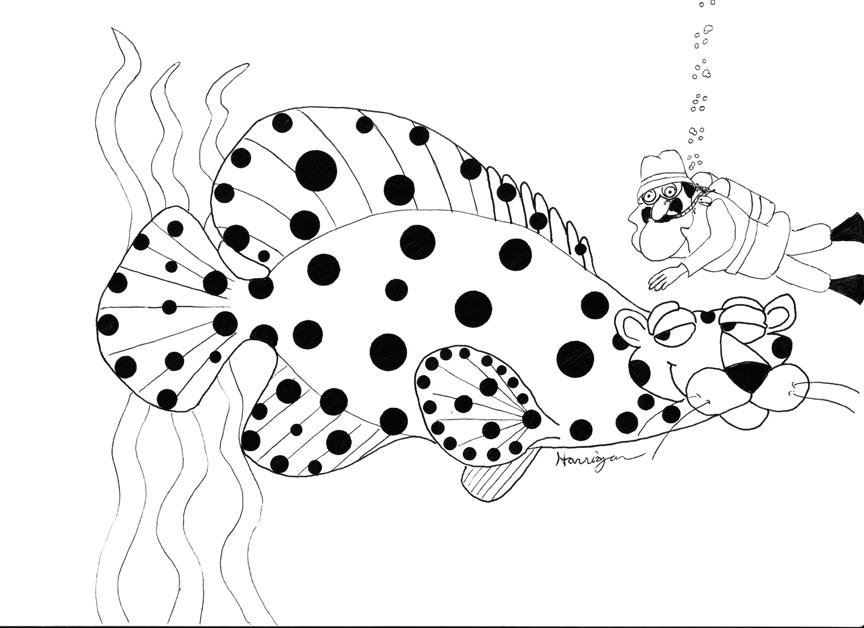
Please make




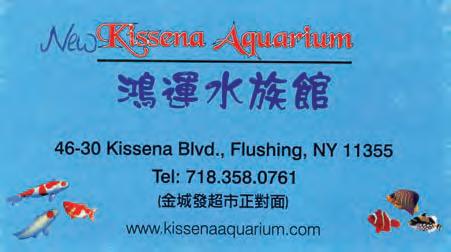

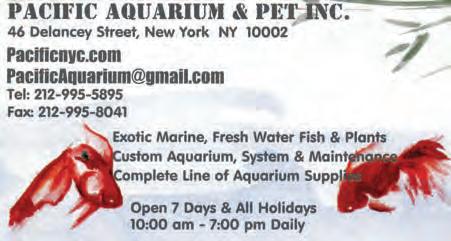



10% Discount on everything.
10% Discount on everything.
10% Discount on everything.
15% Discount on everything in store, or online at: http://www.junglebobaquatics.com Use coupon code gcas15.


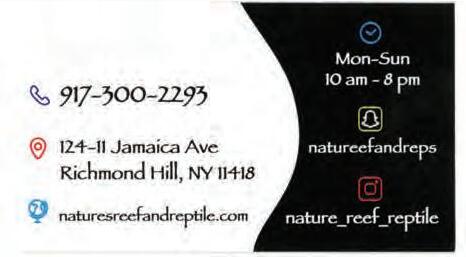
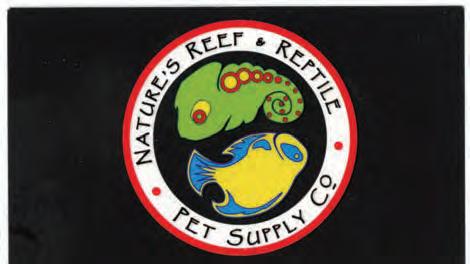


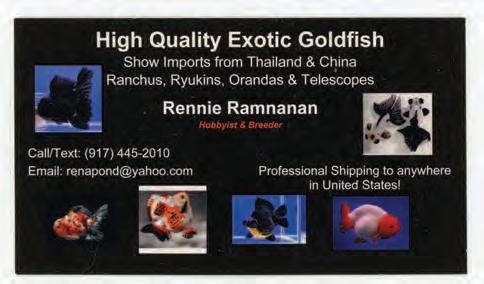


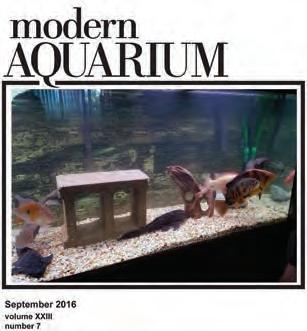
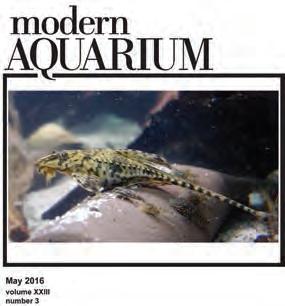

March 2016 Symphysodon discus by Wallace Tao
April 2016 Home Aquarium by Gilberto Soriano
May 2016 Rineloricaria (Hemiloricaria) parva by Ruben Lugo
June 2016 Saltwater Aquarium by Patricia Radebaugh
July 2016 Pseudohemiodon cf. apithanos by Ruben Lugo
August 2016 Fundulopanchax sjoestedti by Rosario LaCorte
September 2016 Home Aquarium by Marsha Radebaugh
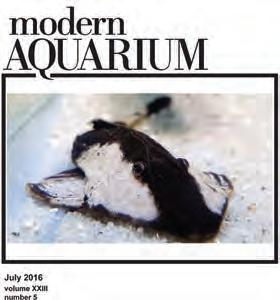
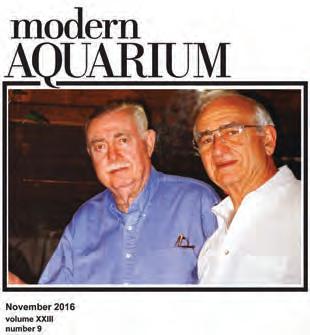


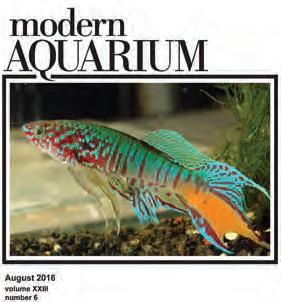
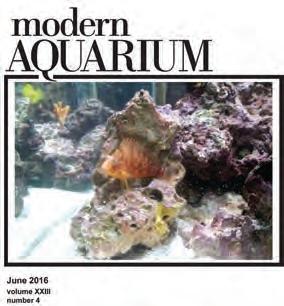
October 2016 Alcyoniidae lovophytum by Joseph F. Gurrado
November 2016 Ross Socolof and Rosario LaCorte by Dick Stratton
December 2016 Sign American Stock Company by Gary Bagnall
In spite of popular demand to the contrary, this humor and information column continues. As usual, it does NOT necessarily represent the opinions of the Editor, or of the Greater City Aquarium Society.


Marine biologists have discovered a frightening new species of sea monster with 20 arms, and have given it a pretty bizarre name to match its equally odd appearance. It all started when a group of scientists embarked on a series of expeditions through the Southern Ocean between 2008 and 2017.
The whole purpose of the mission was to hunt for 'cryptic' sea animals known as Promachocrinus if you're fancy, and Antarctic feather stars if you're not. Although more similar to other invertebrates like starfish and sea cucumbers, the creatures - which sport an 'otherworldly appearance' when swimming - are 'large' in size and can live up to 6,500 feet below the water's surface.
The group found eight totally unique species on their expeditions, including four which had never before been named by scientists. One of these has now been named, Promachocrinus fragarius, the Antarctic strawberry feather star. Sounds weirdly quite pretty, considering its appearance is akin to the creature from the Alien movie. The creatures were named after their 'strawberry-like' body from which 20 spindly arms branch off. The team noted that the Antarctic strawberry feather star can also range in its coloring - from 'purplish' all the way to 'dark reddish'. The research team for the discovery included Emily McLaughlin, Nerida Wilson and Greg Rouse, who identified the Antarctic strawberry feather star as a new species based on its body shape and DNA analysis. The Search for Extraterrestrial Intelligence (SETI) Institute, has scoured the skies for radio signals from intelligent beings ever since 1984. Then there are the space telescopes (Hubble, James Webb, etc.), all searching for alien life. Meanwhile it seems that the alien(s) may already be here!
Reference: https://tinyurl.com/2s45cf5n
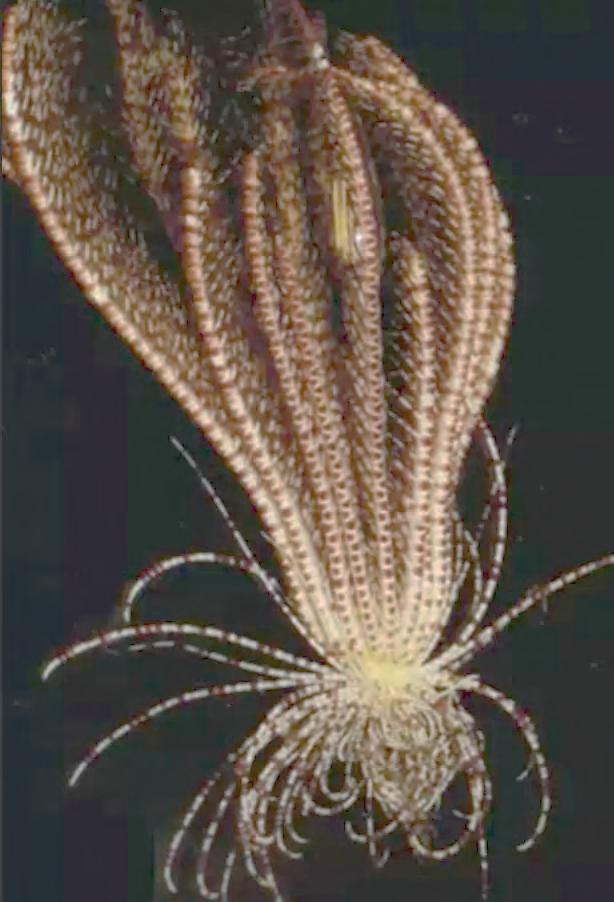
Match the common names of the fish in the box below with their scientific names. Solution next month.
Red phantom tetra
Red eye tetra
Red tailed black shark
Epalzeorhynchos bicolor
Amphilophus labiatus
Ptereleotris calliura
Red devil Betta smaragdina
White -eye goby
White bream


White line topminnow
White bonnet anemone
Acanthurus coeruleus
Fundulopanchax sjostedti
Amphiprion leucokranos
Hyphessobrycon sweglesi
Blue gularis Bollmannia boqueronensis
Blue betta Moenkhausia
Blue tang
Blicca bjoerkna
Blue goby Fundulus albolineatus
